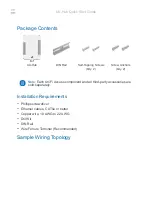MPC563XM Reference Manual, Rev. 1
798
Freescale Semiconductor
Preliminary—Subject to Change Without Notice
b.
the SPRAM was not accessed during the last arbitration slot for the microengine and the host
does not loose the access to the other engine in the current arbitration slot
1
.
c.
CDC is transferring data, after its first (read) access. Note that the CDC can be in middle of a
data transfer of another pair of parameters, unrelated to the ones that microengine tries to
access.
3. The eTPU microengine takes priority for SPRAM accesses under either of the following
conditions:
a.
the Host CPU or CDC has done a data transfer during the last access arbitration slot for the
engine
. Also, the Host CPU does not hold a pending access against the other eTPU
microengine.
b.
the microengine is arbitrating for the access of its second parameter in a back-to-back access
All pairs of back-to-back parameter accesses are coherent with respect to Host and CDC (not
to the other microengine).
The direction (read or write) of any individual access by Host or microengine is irrelevant to the
arbitration. The use of Normal or PSE SPRAM area by the Host is also irrelevant to the arbitration.
The first parameter preloading in a TST is considered first access by the arbiter, regardless of any access
made at the END microinstruction of the previous thread, i.e.: the last access of a thread and the first
preload are never considered a back-to-back access. On the other hand, the TST preload accesses are
considered back-to-back and are, therefore, atomic with respect to Host or CDC.
NOTE
Section 23.4.9.1.5, “Zero SPRAM
) is considered an SPRAM access for arbitration purposes both on
writes and reads; the fact that read SPRAM data is discarded is irrelevant for
arbitration.
23.4.5
Enhanced Channels
Enhanced Channels comprise hardware support for input digital signal processing and output signal
generation. Each Channel is associated with one input and one output signal. Enhanced Channel logic is
combined with Function microcode (and optionally Angle Mode logic) to implement Channel I/O
functionality.
eTPU’s Enhanced Channels are capable of
dual action
, meaning that each channel logic can handle two
events at different times and/or cause two separated actions - these actions and events can be mutually
dependent (with the first either blocking or enabling the other), or both independent, depending on the
programmed
Channel Mode
.
Each Enhanced Channel contains event logic containing two
Event Register sets
, each set supporting one
input and/or output action, the pair implementing dual action support. Each Event Register set contains
two 24 bit registers: Match and Capture. The
Match register
holds the pending match value which is
compared against one of the two time bases by an equal-only/greater-equal comparator. The
Capture
1.
The microengine access slot is between its own T4 and T2 edges (see
Section 23.6.1, “Microcycle and I/O Timing
)).


















